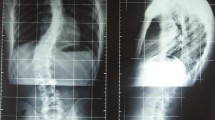Abstract
Sternoclavicular injuries are relatively rare, composing less than 1 % of all musculoskeletal fractures or dislocations. When sternoclavicular injuries do occur, they typically present as an isolated dislocation of the sternoclavicular joint without associated fracture of the clavicle or manubrium. However, in patients with unfused medial clavicle physis, sternoclavicular joint injuries can present as a fracture-dislocation through the unfused physis. These physeal injuries are important to recognize as the displaced epiphysis can block reduction of the sternoclavicular joint. We present a case of a 15-year-old female basketball player presenting with suspected sternoclavicular joint injury after sustaining a direct blow to the left shoulder. An initial shoulder CT confirmed the presence of the clinically suspected posterior sternoclavicular dislocation without fracture identified. An MRI of the left sternoclavicular joint was then performed for suspected physeal fracture, which confirmed the presence of a fracture through the medial clavicle physis with anterior displacement of the unossified epiphysis, blocking reduction of the metaphysis. Given the findings on MRI, the pediatric orthropedic surgeon was able to counsel the family of the high likelihood of failed closed reduction of the sternoclavicular joint requiring conversion to open reduction and internal fixation. The patient underwent successful open reduction and internal fixation of the medial clavical physeal fracture after an initial gentle attempt at closed reduction was unsuccessful.





Similar content being viewed by others
Abbreviations
- AP:
-
Anterior-posterior
- CT:
-
Computerized tomography
- MRI:
-
Magnetic resonance imaging
References
Nettles JL, Linscheid RL. Sternoclavicular dislocations. J Trauma. 1968;8(2):158–64.
Boesmueller S, Wech M, Tiefenboeck TM, Popp D, et al. Incidence, characteristics and long-term follow-up of sternoclavicular injuries—an epidemiological analysis of 92 cases. J Trauma Acute Care Surg. 2015.
Tepolt F, Carry PM, Heyn PC, Miller NH. Posterior sternoclavicular joint injuries in the adolescent population: a meta-analysis. Am J Sports Med. 2014;42(10):2517–24.
Lee JT, Nasreddine AY, Black EM, Bae DS, Kocher MS. Posterior sternoclavicular joint injuries in skeletally immature patients. J Pediatr Orthop. 2014;34:369–75.
Salter RB, Harris WR. Injuries involving the epiphyseal plate. J Bone Joint Surg Am. 1963;45(3):587–622.
Rang, Mercer, ed. 1968. The growth plate and its disorders. Harcourt Brace/Churchill Livingstone. ISBN 978-0-443-00568-8
Ogden JA. Skeletal growth mechanism injury patterns. J Pediatr Orthop. 1982;2(4):371–7.
Mann DC, Rajmaira S. Distribution of physeal and nonphyseal fractures in 2,650 long-bone fractures in children aged 0–16 years. J Pediatr Orthop. 1990;10(6):713–6.
Neer CS, Horowitz BS. Fractures of the proximal humeral epiphyseal plate. Clin Orthop Relat Res. 1965;41:24–31.
Kirby JC, Edwards E, Kamali-Moaveni A. Management and functional outcomes following sternoclavicular joint dislocation. Injury. 2015;46(10):1906–13.
Glass ER, Thompson JD, Cole PA, Gause 2nd TM, Altman GT. Treatment of sternoclavicular joint dislocations: a systematic review of 251 dislocations in 24 case series. J Trauma. 2011;70(5):1294–8.
Allman FL. Fractures and ligamentous injuries of the clavicle and its articulation. J Bone Joint Surg Am. 1967;49(4):774–84.
Ono K, Inagawa H, Kiyota K, Terada T, Suzuki S, Maekawa K. Posterior dislocation of the sternoclavicular joint with obstruction of the innominate vein: case report. J Trauma. 1998;44(2):381–3.
Mehta JC, Sachdev A, Collins JJ. Retrosternal dislocation of the clavicle. Injury. 1973;5(1):79–83.
Rockwood CA, Wilkins KE, Beaty JH, Kasser JR. Rockwood and Wilkins’ fractures in children. 6th ed. Philadelphia: Lippincott Williams & Wilkins; 2006.
Owings-Webb PA, Suchey JM. Epiphyseal union of the anterior iliac crest and medial clavicle in a modern multiracial sample of American males and females. Am J Phys Anthropol. 1985;68:457–66.
Author information
Authors and Affiliations
Corresponding author
Ethics declarations
Conflicts of interest
The authors declare that they have no conflict of interest.
Rights and permissions
About this article
Cite this article
Beckmann, N., Crawford, L. Posterior sternoclavicular Salter-Harris fracture-dislocation in a patient with unossified medial clavicle epiphysis. Skeletal Radiol 45, 1123–1127 (2016). https://doi.org/10.1007/s00256-016-2399-2
Received:
Revised:
Accepted:
Published:
Issue Date:
DOI: https://doi.org/10.1007/s00256-016-2399-2




